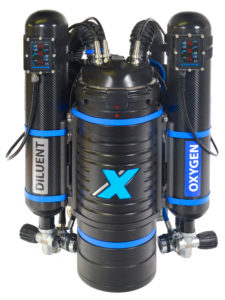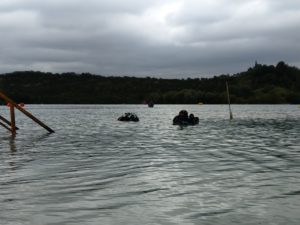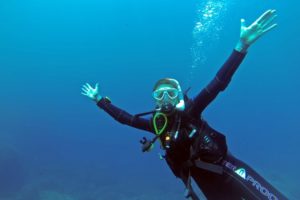During recreational diving, we have to have the possibility of underwater vision, movement and breathing. We also need to protect your body from hypothermia. Therefore, there is a minimum set of elements, the use of which provides us with a comfortable and safe being in a foreign environment. Here is a list and a brief description of such items:
- ABC (mask, fins, snorkel) – minimum set is mask and fins
- Wet suit and shoes. Diving in colder waters also requires gloves and hood
- Buoyancy Control Device (also known as BCD)
- Regulators set (1st stage + 2nd stage + octopus (emergency air source)
- Weights
- Diving computer – optional
- Mask – preferably with tempered glass.
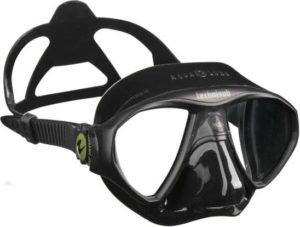 After proper preparation, it is very easy to avoid the evaporation of glass under water. Unfortunately, masks with plastic lenses do not always have such comfort. Masks may have one or two glasses. In some models, it is possible to replace the original windows on the glass with corrective lenses. The silicone seal around the mask should be soft enough so sucked face mask remained on it without a strap. Adjust the straps should be comfortable enough so that under the water it is possible to adjust the tension in the gloves without unnecessary ‘tamping’ on the hooks. Note: Do not be too hard to stretch the belt, as this will strain the silicone face mask and start to leak.
After proper preparation, it is very easy to avoid the evaporation of glass under water. Unfortunately, masks with plastic lenses do not always have such comfort. Masks may have one or two glasses. In some models, it is possible to replace the original windows on the glass with corrective lenses. The silicone seal around the mask should be soft enough so sucked face mask remained on it without a strap. Adjust the straps should be comfortable enough so that under the water it is possible to adjust the tension in the gloves without unnecessary ‘tamping’ on the hooks. Note: Do not be too hard to stretch the belt, as this will strain the silicone face mask and start to leak.  The simplest division is fin boot and fin strip. Fins strip (sometimes instead of the rubber belt divers used to use steel springs) allow divers to fix a fin on a boot. Fins should be matched to the skill level of the diver and what is more important for his physical condition. Pen too hard will cause discomfort, faster fatigue, and sometimes even muscle spasms – what might be dangerous under water and often requires the help of a partner. The unexpected contraction may cause the diver panic under water, and it may cause fatal consequences.
The simplest division is fin boot and fin strip. Fins strip (sometimes instead of the rubber belt divers used to use steel springs) allow divers to fix a fin on a boot. Fins should be matched to the skill level of the diver and what is more important for his physical condition. Pen too hard will cause discomfort, faster fatigue, and sometimes even muscle spasms – what might be dangerous under water and often requires the help of a partner. The unexpected contraction may cause the diver panic under water, and it may cause fatal consequences.
The second, a fairly common mistake is to assume the mask too high on the face. This results in leakage around the nose and with prolonged pain soft cartilage at the bottom of the nose. Fins – There are many types of fins. - The suit is a part that protects the diver’s body against getting cold.
 Water conducts heat 24 times faster than air. That’s why we have the impression that the air temperature of 20 deg. C gives us a sense of comfort, and after a certain residence time in the water at the same temperature, we will be cold. Suits can be divided into two types: wet and dry. The most common suits are wet or semi-dry. They vary in the scope of protection (maybe full body or short, with an integrated hood or not) and the thickness. Mostly the foams are having a thickness of 3, 5 and 7 mm. Wet suits are made of neoprene foam, with reinforcements on the knees, elbows and shoulders (where comes the vest). Thicker suits are equipped with a double collar on the legs and sleeves, which allows for the insertion of shoe uppers or cuff gloves between them and an additional hindrance to the free flow of water.
Water conducts heat 24 times faster than air. That’s why we have the impression that the air temperature of 20 deg. C gives us a sense of comfort, and after a certain residence time in the water at the same temperature, we will be cold. Suits can be divided into two types: wet and dry. The most common suits are wet or semi-dry. They vary in the scope of protection (maybe full body or short, with an integrated hood or not) and the thickness. Mostly the foams are having a thickness of 3, 5 and 7 mm. Wet suits are made of neoprene foam, with reinforcements on the knees, elbows and shoulders (where comes the vest). Thicker suits are equipped with a double collar on the legs and sleeves, which allows for the insertion of shoe uppers or cuff gloves between them and an additional hindrance to the free flow of water.  The neck is protected by a rubber collar, under which you put the hood’s collar which protects the head from heat loss. On the cool water, special warmers, whose job it is additional insulation of the torso.
The neck is protected by a rubber collar, under which you put the hood’s collar which protects the head from heat loss. On the cool water, special warmers, whose job it is additional insulation of the torso.  Generally, the principle of operation is simple: after entry into the water, between the diver’s body and the inner side of the foam, a thin film of water is created. That water does not come out of the foam. It is heated from the diver’s body but is sealed off from the cold water to the outside through the air bubbles contained in the neoprene suit. Impending water exchange through the tight collars we make the heat loss is very slow. Drysuits are a slightly different technique. They are used mostly by technical divers, although recently more and more often are selected by recreational divers for the cool waters. With some techniques, they allow very long staying under water. Some divers in extremely unfavorable conditions (eg. under ice) use electric heating systems that provide additional heat for torso and hands.
Generally, the principle of operation is simple: after entry into the water, between the diver’s body and the inner side of the foam, a thin film of water is created. That water does not come out of the foam. It is heated from the diver’s body but is sealed off from the cold water to the outside through the air bubbles contained in the neoprene suit. Impending water exchange through the tight collars we make the heat loss is very slow. Drysuits are a slightly different technique. They are used mostly by technical divers, although recently more and more often are selected by recreational divers for the cool waters. With some techniques, they allow very long staying under water. Some divers in extremely unfavorable conditions (eg. under ice) use electric heating systems that provide additional heat for torso and hands.
- BCD (Buoyancy Control Device) is a piece of equipment that regardless of the depth allows the diver to maintain neutral buoyancy (weightlessness).
 The most common is the BCD vest and wing. They differ structurally, although the principle is the same. Once it accepted to think that the vests are for recreational divers and the wings for technical divers. Currently, this division is no longer maintained – an increasing number of recreational divers choose wing or so-called hybrid. In the picture, you can see an example of BCD (namely the model that is a cross between a vest and wing – a hybrid). The corrugated hose over the left shoulder is called inflator. It is connected with a hose to the port of the average pressure in the first stage regulator (about which more will write below). The inflator has two buttons, one for filling a bag buoyancy and the other for releasing air from it. At the bottom is a ballast system (with red handles). The vest is strapped with a belt equipped with velcro and a clamp at the lower part and upper buckle. Additionally, the vest is equipped with a certain amount of so-called D-rings, which is used for easy mounting of additional equipment which is useful in water (such as torches, buoys, photographic equipment, nets, etc.).
The most common is the BCD vest and wing. They differ structurally, although the principle is the same. Once it accepted to think that the vests are for recreational divers and the wings for technical divers. Currently, this division is no longer maintained – an increasing number of recreational divers choose wing or so-called hybrid. In the picture, you can see an example of BCD (namely the model that is a cross between a vest and wing – a hybrid). The corrugated hose over the left shoulder is called inflator. It is connected with a hose to the port of the average pressure in the first stage regulator (about which more will write below). The inflator has two buttons, one for filling a bag buoyancy and the other for releasing air from it. At the bottom is a ballast system (with red handles). The vest is strapped with a belt equipped with velcro and a clamp at the lower part and upper buckle. Additionally, the vest is equipped with a certain amount of so-called D-rings, which is used for easy mounting of additional equipment which is useful in water (such as torches, buoys, photographic equipment, nets, etc.).
 A regulator is a device that allows breathing underwater using compressed at high-pressure gas (usually air) in the cylinder, but getting this gas at a pressure adjusted to the depth at which it is currently in. The kit consists of the first stage regulator (see the image beside), which is an element screwed into the cylinder valve. The first stage is equipped with at least one port of high pressure (HP), which is used for hose with a pressure gauge (this allows us to control the amount of gas which still has the bottle). If the first stage has two HP ports, in the second we can put the pressure sensor that will transmit this information by radio to the dive computer. Thus we are provided with double control of the quantity of gas which we still remained in the tank. The first stage shown in the picture is equipped with two high-pressure ports.
A regulator is a device that allows breathing underwater using compressed at high-pressure gas (usually air) in the cylinder, but getting this gas at a pressure adjusted to the depth at which it is currently in. The kit consists of the first stage regulator (see the image beside), which is an element screwed into the cylinder valve. The first stage is equipped with at least one port of high pressure (HP), which is used for hose with a pressure gauge (this allows us to control the amount of gas which still has the bottle). If the first stage has two HP ports, in the second we can put the pressure sensor that will transmit this information by radio to the dive computer. Thus we are provided with double control of the quantity of gas which we still remained in the tank. The first stage shown in the picture is equipped with two high-pressure ports. The first stage also has four medium-pressure ports (MP). In the recreation configuration, they are used to connect the so-called second stage regulator which is an element through which we breathe under the water, the backup regulator, also known as octopus (octopus usually is made of yellow plastic). The third port is connected to the inflator vest which is described above. The fourth port is used when instead of the wet suit we are going to use a dry suit. Drysuits are equipped with additional valves that can inflate air to the suit or let them out of it. The whole suit then behaves just like a buoyancy vest. In the next picture, you can see a set manufactured by Apeks and consist of the first stage FSR XTX-200 and second stage XTX-50.
The first stage also has four medium-pressure ports (MP). In the recreation configuration, they are used to connect the so-called second stage regulator which is an element through which we breathe under the water, the backup regulator, also known as octopus (octopus usually is made of yellow plastic). The third port is connected to the inflator vest which is described above. The fourth port is used when instead of the wet suit we are going to use a dry suit. Drysuits are equipped with additional valves that can inflate air to the suit or let them out of it. The whole suit then behaves just like a buoyancy vest. In the next picture, you can see a set manufactured by Apeks and consist of the first stage FSR XTX-200 and second stage XTX-50.
- Weights. A diver dressed in a wet or dry suit has a large positive buoyancy which means that it will have a problem with the immersion. Its buoyancy is greater, the thicker wearing wet suit.
 Very important it is to choose the correct amount of weights so that he was neither too much nor too little. Incorrect amount of ballast may end up uncontrolled surfaces (when it is not enough), or an increased gas consumption (when the ballast is too much). These issues are described in more detail in the physics of diving. These are things fairly simple, mostly in the field of physics classes in high school (before the Zalewska reforms), but beyond the topic addressed here. Weights are in the form of lead tiles mass 1, 2 or 3 kg. Tiles have cutouts that allow the protraction of the belt. As mentioned above, however, some vests are equipped with ballast pockets, to which such lead cubes are put in and fastened with Velcro. Dropping ballast is to pull-out such pocket and the rejection of it.
Very important it is to choose the correct amount of weights so that he was neither too much nor too little. Incorrect amount of ballast may end up uncontrolled surfaces (when it is not enough), or an increased gas consumption (when the ballast is too much). These issues are described in more detail in the physics of diving. These are things fairly simple, mostly in the field of physics classes in high school (before the Zalewska reforms), but beyond the topic addressed here. Weights are in the form of lead tiles mass 1, 2 or 3 kg. Tiles have cutouts that allow the protraction of the belt. As mentioned above, however, some vests are equipped with ballast pockets, to which such lead cubes are put in and fastened with Velcro. Dropping ballast is to pull-out such pocket and the rejection of it.
- The dive computer is a must-have device for a frequently diving person.
 This is an underwater measurement set, which during a dive shows the diver (and just as importantly, it saves in its memory) the current environmental parameters such as depth, water temperature, dive time, partial pressures of gases, no-decompression limits, etc. Some models are enhanced with features like compass or diving gases other than air, allow switching between gases under the water, they can read the cylinder pressure from the radio probe described above (and visible on the picture).
This is an underwater measurement set, which during a dive shows the diver (and just as importantly, it saves in its memory) the current environmental parameters such as depth, water temperature, dive time, partial pressures of gases, no-decompression limits, etc. Some models are enhanced with features like compass or diving gases other than air, allow switching between gases under the water, they can read the cylinder pressure from the radio probe described above (and visible on the picture). A properly calibrated computer will watch and warn the diver when it is too deep or too long under water. It will also warn and remind decompression limits, where crossing may result in serious injuries (DCS). Since the computer collects information about the performance of diving and stores them in its memory, it can be a fairly accurate source of information about whether and when we can on that day to make a second or more dive.
A properly calibrated computer will watch and warn the diver when it is too deep or too long under water. It will also warn and remind decompression limits, where crossing may result in serious injuries (DCS). Since the computer collects information about the performance of diving and stores them in its memory, it can be a fairly accurate source of information about whether and when we can on that day to make a second or more dive. There is one condition of course. The principle says that each diver swims with its own computer. The data gathered during the dive can be transmitted to a laptop (if the dive computer has the appropriate interface – it’s not a rule!). This functionality makes it easy to conduct your own Logbook. Computers have a different look and a different range of functionality. However, the common feature is to have built-in decompression tables, without knowing that diving would not be so safe sport. Most modern computers are equipped with decompression tables calculated on the basis of a fairly modern algorithm RGBM (Reduced Gradient Bubble Model) developed by Dr. Bruce Wienke. The whole decompression theory is quite a complex issue and is discussed in diving courses. The more advanced course, the more accurately and more widely discussed diving physiology and decompression theory.
There is one condition of course. The principle says that each diver swims with its own computer. The data gathered during the dive can be transmitted to a laptop (if the dive computer has the appropriate interface – it’s not a rule!). This functionality makes it easy to conduct your own Logbook. Computers have a different look and a different range of functionality. However, the common feature is to have built-in decompression tables, without knowing that diving would not be so safe sport. Most modern computers are equipped with decompression tables calculated on the basis of a fairly modern algorithm RGBM (Reduced Gradient Bubble Model) developed by Dr. Bruce Wienke. The whole decompression theory is quite a complex issue and is discussed in diving courses. The more advanced course, the more accurately and more widely discussed diving physiology and decompression theory.

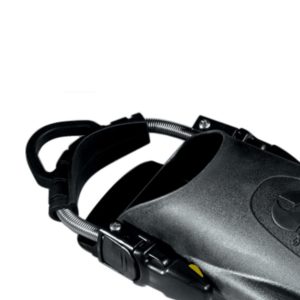 The simplest division is fin boot and fin strip. Fins strip (sometimes instead of the rubber belt divers used to use steel springs) allow divers to fix a fin on a boot. Fins should be matched to the skill level of the diver and what is more important for his physical condition. Pen too hard will cause discomfort, faster fatigue, and sometimes even muscle spasms – what might be dangerous under water and often requires the help of a partner. The unexpected contraction may cause the diver panic under water, and it may cause fatal consequences.
The simplest division is fin boot and fin strip. Fins strip (sometimes instead of the rubber belt divers used to use steel springs) allow divers to fix a fin on a boot. Fins should be matched to the skill level of the diver and what is more important for his physical condition. Pen too hard will cause discomfort, faster fatigue, and sometimes even muscle spasms – what might be dangerous under water and often requires the help of a partner. The unexpected contraction may cause the diver panic under water, and it may cause fatal consequences.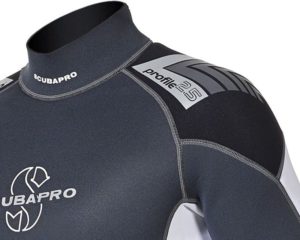 Water conducts heat 24 times faster than air. That’s why we have the impression that the air temperature of 20 deg. C gives us a sense of comfort, and after a certain residence time in the water at the same temperature, we will be cold. Suits can be divided into two types: wet and dry. The most common suits are wet or semi-dry. They vary in the scope of protection (maybe full body or short, with an integrated hood or not) and the thickness. Mostly the foams are having a thickness of 3, 5 and 7 mm. Wet suits are made of neoprene foam, with reinforcements on the knees, elbows and shoulders (where comes the vest). Thicker suits are equipped with a double collar on the legs and sleeves, which allows for the insertion of shoe uppers or cuff gloves between them and an additional hindrance to the free flow of water.
Water conducts heat 24 times faster than air. That’s why we have the impression that the air temperature of 20 deg. C gives us a sense of comfort, and after a certain residence time in the water at the same temperature, we will be cold. Suits can be divided into two types: wet and dry. The most common suits are wet or semi-dry. They vary in the scope of protection (maybe full body or short, with an integrated hood or not) and the thickness. Mostly the foams are having a thickness of 3, 5 and 7 mm. Wet suits are made of neoprene foam, with reinforcements on the knees, elbows and shoulders (where comes the vest). Thicker suits are equipped with a double collar on the legs and sleeves, which allows for the insertion of shoe uppers or cuff gloves between them and an additional hindrance to the free flow of water. 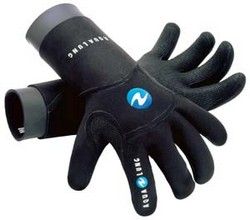 The neck is protected by a rubber collar, under which you put the hood’s collar which protects the head from heat loss. On the cool water, special warmers, whose job it is additional insulation of the torso.
The neck is protected by a rubber collar, under which you put the hood’s collar which protects the head from heat loss. On the cool water, special warmers, whose job it is additional insulation of the torso. 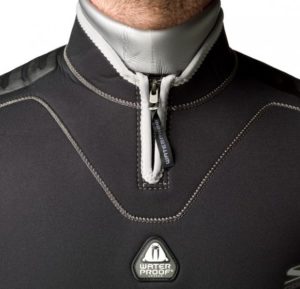 Generally, the principle of operation is simple: after entry into the water, between the diver’s body and the inner side of the foam, a thin film of water is created. That water does not come out of the foam. It is heated from the diver’s body but is sealed off from the cold water to the outside through the air bubbles contained in the neoprene suit. Impending water exchange through the tight collars we make the heat loss is very slow. Drysuits are a slightly different technique. They are used mostly by technical divers, although recently more and more often are selected by recreational divers for the cool waters. With some techniques, they allow very long staying under water. Some divers in extremely unfavorable conditions (eg. under ice) use electric heating systems that provide additional heat for torso and hands.
Generally, the principle of operation is simple: after entry into the water, between the diver’s body and the inner side of the foam, a thin film of water is created. That water does not come out of the foam. It is heated from the diver’s body but is sealed off from the cold water to the outside through the air bubbles contained in the neoprene suit. Impending water exchange through the tight collars we make the heat loss is very slow. Drysuits are a slightly different technique. They are used mostly by technical divers, although recently more and more often are selected by recreational divers for the cool waters. With some techniques, they allow very long staying under water. Some divers in extremely unfavorable conditions (eg. under ice) use electric heating systems that provide additional heat for torso and hands.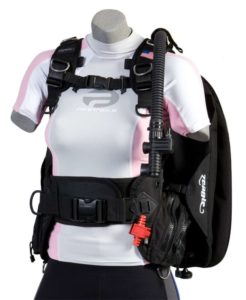 The most common is the BCD vest and wing. They differ structurally, although the principle is the same. Once it accepted to think that the vests are for recreational divers and the wings for technical divers. Currently, this division is no longer maintained – an increasing number of recreational divers choose wing or so-called hybrid. In the picture, you can see an example of BCD (namely the model that is a cross between a vest and wing – a hybrid). The corrugated hose over the left shoulder is called inflator. It is connected with a hose to the port of the average pressure in the first stage regulator (about which more will write below). The inflator has two buttons, one for filling a bag buoyancy and the other for releasing air from it. At the bottom is a ballast system (with red handles). The vest is strapped with a belt equipped with velcro and a clamp at the lower part and upper buckle. Additionally, the vest is equipped with a certain amount of so-called D-rings, which is used for easy mounting of additional equipment which is useful in water (such as torches, buoys, photographic equipment, nets, etc.).
The most common is the BCD vest and wing. They differ structurally, although the principle is the same. Once it accepted to think that the vests are for recreational divers and the wings for technical divers. Currently, this division is no longer maintained – an increasing number of recreational divers choose wing or so-called hybrid. In the picture, you can see an example of BCD (namely the model that is a cross between a vest and wing – a hybrid). The corrugated hose over the left shoulder is called inflator. It is connected with a hose to the port of the average pressure in the first stage regulator (about which more will write below). The inflator has two buttons, one for filling a bag buoyancy and the other for releasing air from it. At the bottom is a ballast system (with red handles). The vest is strapped with a belt equipped with velcro and a clamp at the lower part and upper buckle. Additionally, the vest is equipped with a certain amount of so-called D-rings, which is used for easy mounting of additional equipment which is useful in water (such as torches, buoys, photographic equipment, nets, etc.).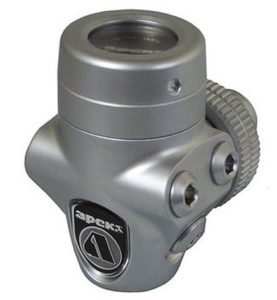 A regulator is a device that allows breathing underwater using compressed at high-pressure gas (usually air) in the cylinder, but getting this gas at a pressure adjusted to the depth at which it is currently in. The kit consists of the first stage regulator (see the image beside), which is an element screwed into the cylinder valve. The first stage is equipped with at least one port of high pressure (HP), which is used for hose with a pressure gauge (this allows us to control the amount of gas which still has the bottle). If the first stage has two HP ports, in the second we can put the pressure sensor that will transmit this information by radio to the dive computer. Thus we are provided with double control of the quantity of gas which we still remained in the tank. The first stage shown in the picture is equipped with two high-pressure ports.
A regulator is a device that allows breathing underwater using compressed at high-pressure gas (usually air) in the cylinder, but getting this gas at a pressure adjusted to the depth at which it is currently in. The kit consists of the first stage regulator (see the image beside), which is an element screwed into the cylinder valve. The first stage is equipped with at least one port of high pressure (HP), which is used for hose with a pressure gauge (this allows us to control the amount of gas which still has the bottle). If the first stage has two HP ports, in the second we can put the pressure sensor that will transmit this information by radio to the dive computer. Thus we are provided with double control of the quantity of gas which we still remained in the tank. The first stage shown in the picture is equipped with two high-pressure ports.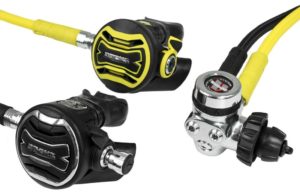 The first stage also has four medium-pressure ports (MP). In the recreation configuration, they are used to connect the so-called second stage regulator which is an element through which we breathe under the water, the backup regulator, also known as octopus (octopus usually is made of yellow plastic). The third port is connected to the inflator vest which is described above. The fourth port is used when instead of the wet suit we are going to use a dry suit. Drysuits are equipped with additional valves that can inflate air to the suit or let them out of it. The whole suit then behaves just like a buoyancy vest. In the next picture, you can see a set manufactured by Apeks and consist of the first stage FSR XTX-200 and second stage XTX-50.
The first stage also has four medium-pressure ports (MP). In the recreation configuration, they are used to connect the so-called second stage regulator which is an element through which we breathe under the water, the backup regulator, also known as octopus (octopus usually is made of yellow plastic). The third port is connected to the inflator vest which is described above. The fourth port is used when instead of the wet suit we are going to use a dry suit. Drysuits are equipped with additional valves that can inflate air to the suit or let them out of it. The whole suit then behaves just like a buoyancy vest. In the next picture, you can see a set manufactured by Apeks and consist of the first stage FSR XTX-200 and second stage XTX-50.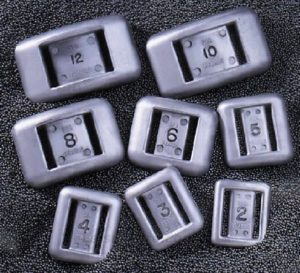 Very important it is to choose the correct amount of weights so that he was neither too much nor too little. Incorrect amount of ballast may end up uncontrolled surfaces (when it is not enough), or an increased gas consumption (when the ballast is too much). These issues are described in more detail in the physics of diving. These are things fairly simple, mostly in the field of physics classes in high school (before the Zalewska reforms), but beyond the topic addressed here. Weights are in the form of lead tiles mass 1, 2 or 3 kg. Tiles have cutouts that allow the protraction of the belt. As mentioned above, however, some vests are equipped with ballast pockets, to which such lead cubes are put in and fastened with Velcro. Dropping ballast is to pull-out such pocket and the rejection of it.
Very important it is to choose the correct amount of weights so that he was neither too much nor too little. Incorrect amount of ballast may end up uncontrolled surfaces (when it is not enough), or an increased gas consumption (when the ballast is too much). These issues are described in more detail in the physics of diving. These are things fairly simple, mostly in the field of physics classes in high school (before the Zalewska reforms), but beyond the topic addressed here. Weights are in the form of lead tiles mass 1, 2 or 3 kg. Tiles have cutouts that allow the protraction of the belt. As mentioned above, however, some vests are equipped with ballast pockets, to which such lead cubes are put in and fastened with Velcro. Dropping ballast is to pull-out such pocket and the rejection of it.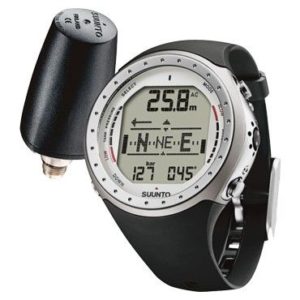 This is an underwater measurement set, which during a dive shows the diver (and just as importantly, it saves in its memory) the current environmental parameters such as depth, water temperature, dive time, partial pressures of gases, no-decompression limits, etc. Some models are enhanced with features like compass or diving gases other than air, allow switching between gases under the water, they can read the cylinder pressure from the radio probe described above (and visible on the picture).
This is an underwater measurement set, which during a dive shows the diver (and just as importantly, it saves in its memory) the current environmental parameters such as depth, water temperature, dive time, partial pressures of gases, no-decompression limits, etc. Some models are enhanced with features like compass or diving gases other than air, allow switching between gases under the water, they can read the cylinder pressure from the radio probe described above (and visible on the picture).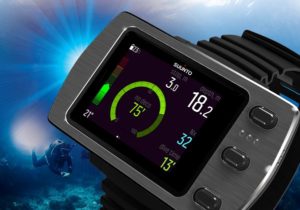 A properly calibrated computer will watch and warn the diver when it is too deep or too long under water. It will also warn and remind decompression limits, where crossing may result in serious injuries (DCS). Since the computer collects information about the performance of diving and stores them in its memory, it can be a fairly accurate source of information about whether and when we can on that day to make a second or more dive.
A properly calibrated computer will watch and warn the diver when it is too deep or too long under water. It will also warn and remind decompression limits, where crossing may result in serious injuries (DCS). Since the computer collects information about the performance of diving and stores them in its memory, it can be a fairly accurate source of information about whether and when we can on that day to make a second or more dive.


